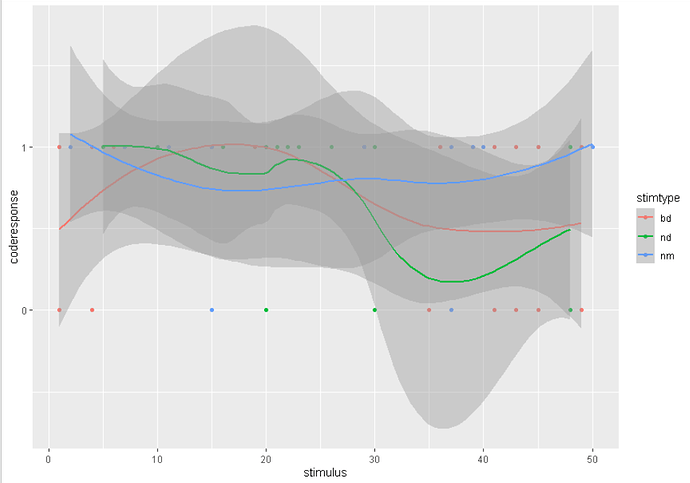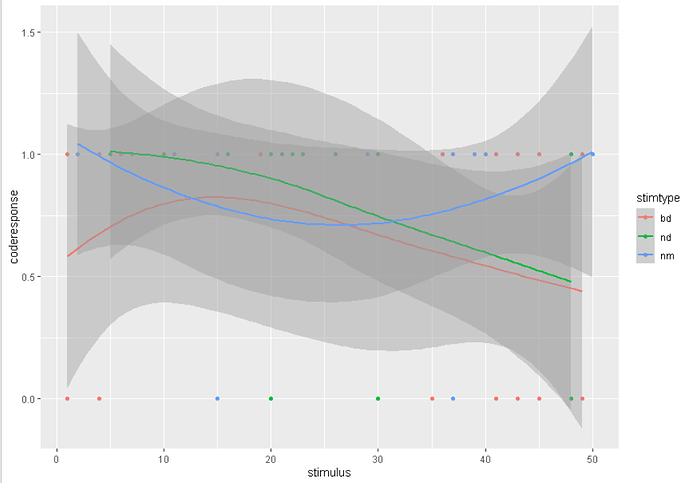have this function that generates a midpoint/decision boundary over certain subgroups of my dataframe -- I've tried creating a dummy dataframe, denoted as "df" below to work with.
## glm that generates a midpoint/decision boundary, wrapped into a function
get_midpoint = function(data){
glm.1 = glm(coderesponse~stimulus, family = binomial(link="logit"), data=data, na.action = na.exclude)
rtn = -glm.1$coefficients[1]/glm.1$coefficients[2]
rtn
}
## a mini dummy dataframe
subject <- c(1, 1, 1, 1, 1, 1, 1, 1, 1, 1, 1, 1, 1, 1, 1, 1, 1, 1, 1, 1, 1, 1, 1, 1, 1, 1, 1, 1, 1, 1, 2, 2, 2, 2, 2, 2, 2, 2, 2, 2, 2, 2, 2, 2, 2, 2, 2, 2, 2, 2, 2, 2, 2, 2, 2, 2, 2, 2, 2, 2)
stimulus = c(1, 5, 50, 35, 23, 2, 4, 22, 15, 6, 20, 40, 45, 10, 37, 43, 48, 7, 19, 21, 29, 49, 26, 11, 36, 30, 39, 41, 16, 37, 1, 5, 50, 35, 23, 2, 4, 22, 15, 6, 20, 40, 45, 10, 37, 43, 48, 7, 19, 21, 29, 49, 26, 11, 36, 30, 39, 41, 16, 37)
stimtype <- c('bd', 'nd', 'nm', 'bd', 'nd', 'nm', 'bd', 'nd', 'nm', 'bd', 'nd', 'nm', 'bd', 'nd', 'nm', 'bd', 'nd', 'nm', 'bd', 'nd', 'nm', 'bd', 'nd', 'nm', 'bd', 'nd', 'nm', 'bd', 'nd', 'nm', 'bd', 'nd', 'nm', 'bd', 'nd', 'nm', 'bd', 'nd', 'nm', 'bd', 'nd', 'nm', 'bd', 'nd', 'nm', 'bd', 'nd', 'nm', 'bd', 'nd', 'nm', 'bd', 'nd', 'nm', 'bd', 'nd', 'nm', 'bd', 'nd', 'nm')
blocktype <- c('mouth', 'mouth', 'mouth', 'nose', 'nose', 'nose', 'mouth', 'mouth', 'mouth', 'nose', 'nose', 'nose', 'mouth', 'mouth', 'mouth', 'nose', 'nose', 'nose', 'mouth', 'mouth', 'mouth', 'nose', 'nose', 'nose', 'mouth', 'mouth', 'mouth', 'nose', 'nose', 'nose', 'mouth', 'mouth', 'mouth', 'nose', 'nose', 'nose', 'mouth', 'mouth', 'mouth', 'nose', 'nose', 'nose', 'mouth', 'mouth', 'mouth', 'nose', 'nose', 'nose', 'mouth', 'mouth', 'mouth', 'nose', 'nose', 'nose', 'mouth', 'mouth', 'mouth', 'nose', 'nose', 'nose')
coderesponse <- c(1, 1, 1, 0, 1, 1, 1, 1, 1, 1, 1, 1, 1, 1, 1, 0, 1, 1, 1, 1, 1, 0, 1, 1, 1, 1, 1, 1, 1, 1, 0, 1, 1, 0, 1, 1, 0, 1, 0, 1, 0, 1, 0, 1, 0, 1, 0, 1, 1, 1, 1, 1, 1, 1, 1, 0, 1, 0, 1, 0)
df = data.frame(subject, stimulus, stimtype, blocktype, coderesponse)
## running the following function over defined subgroups of ~80 rows each [for the real data]
## but for the dummy dataframe, only runs over ~5 rows per subgroup
df = df %>%
nest(data=-c(subject, stimtype, blocktype)) %>%
mutate(midpoint=map_dbl(df, get_midpoint)) %>%
unnest()
## basic code that plots and creates a curve based on a single glm result...?
plot(df$stimulus,df$coderesponse,xlab="stimulus",ylab="Probability of d responses")
curve(predict(glm.1,data.frame(stimulus=x),type="response"),add=TRUE)
I was wondering if it's possible to turn the plot + curve pieces of code into a function that can also be run over the same subgroups? Also, as an extension of the initial question, is it possible then to exclude glm values if their corresponding curve does not meet a certain criteria e.g. whatever makes the curve look flat or not as "S" shaped?
I hope this makes sense -- I'm still learning about modelling/plotting in R. Thank you for any advice in advance!

